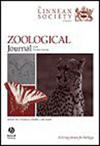陆生等足动物Tiroloscia属中隐藏物种的多样性及其系统发育关系(甲壳纲:等足目:蛇尾纲)
IF 3
2区 生物学
Q1 ZOOLOGY
引用次数: 0
摘要
在过去的几十年里,定义物种边界可能是一个具有挑战性的问题,也是一个广泛争论的问题。在隐蔽或“伪隐蔽”物种的情况下,分子方法可以是一个有价值的工具,提供分类假设和显著补充形态分类学。本文利用两个线粒体标记和一个核标记研究了Tiroloscia属植物的系统发育关系,重点研究了Tiroloscia exigua。此外,我们使用分子钟来定义物种内主要谱系多样化的时间窗口,并探索其进化史的各个方面。最后,采用了四种物种划分方法来明确分类学和验证物种边界。我们发现了强有力的证据反对铁罗香的单系性和惊人的高水平遗传多样性在铁罗香的exigua,形态学支持。值得注意的是,在T. exigua中鉴定出五个进化谱系,表明存在不同的分类实体。分化时间估计表明,T. exigua的分化开始于中新世中期(~12.2 Mya)。基于系统发育和形态学的结果,我们提出了Tiroloscia squamuligera作为一个有效种的复活。我们的研究结果强调了分子方法对揭示隐藏的多样性的重要性,特别是在陆地等足类动物中,这可能隐藏了仍然被低估的生物多样性。本文章由计算机程序翻译,如有差异,请以英文原文为准。
Hidden species’ diversity and phylogenetic relationships within the terrestrial isopod genus Tiroloscia (Crustacea: Isopoda: Oniscidea)
Defining species boundaries may result challenging and has been a widely debated issue in the last decades. In cases of cryptic or “pseudocryptic” species, molecular approaches can be a valuable tool to provide taxonomic hypotheses and significantly complement morphological taxonomy. Here, two mitochondrial and one nuclear markers were used to study the phylogenetic relationships within the genus Tiroloscia, paying particular attention to Tiroloscia exigua. Moreover, we used a molecular clock to define a time window for the diversification of the main lineages within the species and explore aspects of its evolutionary history. Finally, four species delimitation methods were applied to clarify taxonomy and validate species boundaries. We found strong evidence against the monophyly of Tiroloscia and a surprisingly high level of genetic diversity within Tiroloscia exigua, supported by morphology. Notably, five evolutionary lineages were identified within T. exigua, suggesting the presence of distinct taxonomic entities. Divergence time estimation places the onset of T. exigua diversification around the middle Miocene (~12.2 Mya). Based on phylogenetic and morphological results, we propose the resurrection of Tiroloscia squamuligera as a valid species. Our results underscore the importance of molecular approaches to uncover hidden diversity, particularly in terrestrial isopods which may hide still underestimated biodiversity.
求助全文
通过发布文献求助,成功后即可免费获取论文全文。
去求助
来源期刊
CiteScore
6.50
自引率
10.70%
发文量
116
审稿时长
6-12 weeks
期刊介绍:
The Zoological Journal of the Linnean Society publishes papers on systematic and evolutionary zoology and comparative, functional and other studies where relevant to these areas. Studies of extinct as well as living animals are included. Reviews are also published; these may be invited by the Editorial Board, but uninvited reviews may also be considered. The Zoological Journal also has a wide circulation amongst zoologists and although narrowly specialized papers are not excluded, potential authors should bear that readership in mind.

 求助内容:
求助内容: 应助结果提醒方式:
应助结果提醒方式:


